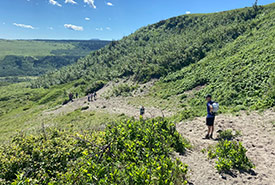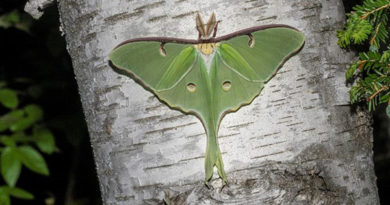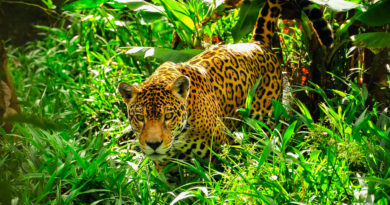NCC: Land Lines – No easy task: Ayla Peacock on battling invasive species in the Crown of the Continent
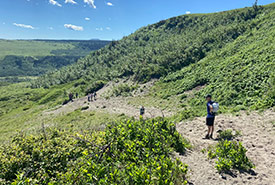
Getting to Conservation Volunteers site often involves a scenic hike through the land. Blind Canyon, AB (Photo by NCC)
I’m lucky enough to work in within the Crown of the Continent, a region straddling the continental divide in the Rocky Mountains that covers corners of Montana, Alberta and British Columbia.
This unique landscape features magnificent and intact coniferous and deciduous forests, grasslands, lakes and high alpine zones. The Crown of the Continent ecosystem provides crucial land connectivity for species migration and sustains incredible biodiversity, including 1,270 vascular plant species, 272 bird species, 63 mammal species and 23 fish species!
It’s also a place steeped in rich history, being home to the Niitsitapi, Ktunaxa, Ksanka, Selis and Qlispe Peoples since time immemorial.
The part of this ecosystem that I work in is in southwest Alberta, within the Waterton and Castle Crowsnest Natural Areas. As an invasive species technician, I am developing and carrying out an invasive species pilot program for the Nature Conservancy of Canada (NCC) in Alberta.
It’s tough but rewarding work.
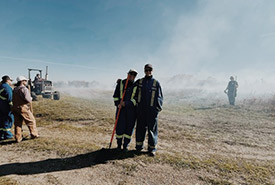
Ayla Peacock and Colin Anderson, NCC’s invasive weed technicians in 2022 (Photo by NCC)
The program started in 2022 when I was hired by NCC alongside a seasonal technician. I was excited to be working in one of the most beautiful places on Earth, but I also knew there would be challenges.
While the biodiversity within these natural areas is rich, so too is the abundance of invasive species. There have been 25 provincially regulated invasive weeds documented on NCC properties in this area. Controlling each requires a different approach — and that’s one of the challenges I face!
But why are there so many weeds here?
This part of Alberta is particularly challenging for invasive species management; that’s because it is located near two borders and is a main throughfare. All this traffic spreads weeds much faster and easier than by natural forces, such as wind or animals. That’s because seeds of invasive weeds can hitchhike on vehicles and road maintenance equipment, allowing them to spread much further and faster.
Also, the area is a hotbed of resource extraction activities. Forestry, oil and gas and mining have all occurred on this landscape, allowing for more invasive species to establish due to disturbance. A biologically diverse and healthy ecosystem often keeps invaders out due to competition, but when a disturbance occurs, invasive species will quickly establish and colonize an area due to a lack of natural predators. This allows invasive species to crowd out and devastate native species in their ecosystems.
While invasive species do not recognize boundaries, control work certainly does. Effective invasive species management happens thanks to collaboration between governments, organizations and other stakeholders.
That, I learned quickly, is no simple feat.
Fortunately, when I started with NCC, a group already existed with the aim to achieve this level of collaboration, known as the Southwest Invasive Managers (SWIM). The folks at SWIM are comprised of federal, provincial and municipal government representatives, NCC staff, Alberta Invasive Species Council staff, and representatives from other conservation organizations. They provide me with invaluable information and strategies as I rolled out and developed NCC’s invasive species program in the area.
But I wasn’t kidding when I said the Waterton and Castle-Crowsnest Natural Areas are extra difficult in terms of weed management. There are a ton of weeds here! So how did I even begin to tackle this problem and develop a program?
Where to begin?
The first step is mapping. You can’t control weeds if you don’t know where they are.
I spent a large portion of the 2022 field season mapping weeds on NCC properties. The goal was to obtain a baseline inventory of invasive species so I could begin to develop an integrated pest management (IPM) plan, which uses multiple tools and strategies for eradicating invasive species, including biological controls, pesticide use, manual controls and cultural control methods. Cultural control methods are non-chemical weed control methods including avoiding overgrazing of rangeland and using native seed mixes to outcompete undesirable vegetation.
Unfortunately, I was unable to complete my mapping campaign in 2022. Not only are these natural areas huge, but I had more to do!
To control invasive species, my seasonal technician and I would often hike into remote locations to chemically treat or hand pull invasives. We did this using a backpack sprayer to limit disturbance and protect the properties we were working on from trucks and UTVs that are similar to ATVs but for work and farm purposes; they often have a box on the back to store equipment.
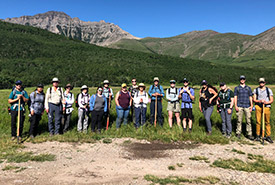
Blind Canyon weed pull event, AB (Photo by NCC)
We also hosted and attended volunteer events where we hand pulled weeds and planted willows, which are fast growing and an important species for bank stabilization and erosion prevention to outcompete potential invaders. We also monitored a biocontrol release site of a stem boring weevil on Dalmatian toadflax and found it to be almost completely eradicated!
In 2023, my goal is to complete the mapping of all properties and develop a weed control strategy for the Waterton Natural Area. I also have big plans for a biocontrol project on spotted knapweed, and I will try mowing on a handful of properties.
I am really looking forward to what the future holds for the Invasive Species Program. The Crown of the Continent is a very special place, and with invasive species being one of the top five threats to biodiversity, this program is becoming increasingly more important.
Watch out, weeds!

